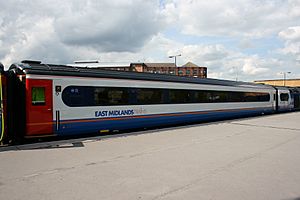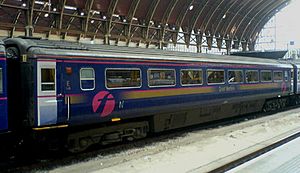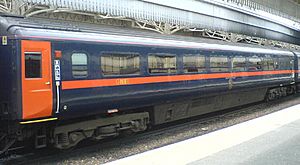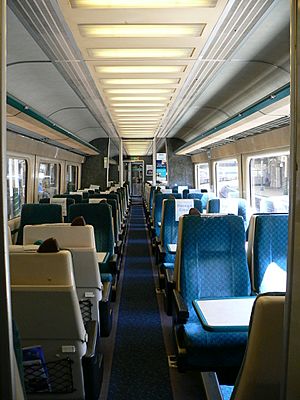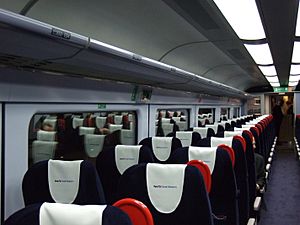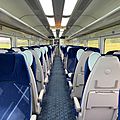British Rail Mark 3 facts for kids
Quick facts for kids British Rail Mark 3 |
|
|---|---|
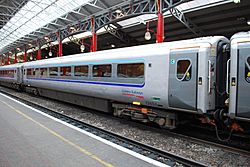
Chiltern Railways Mark 3 with retrofitted plug doors at London Marylebone in August 2012
|
|
| In service | 1975- present |
| Manufacturer | BREL |
| Number built | 848 vehicles |
| Operator(s) | CrossCountry East Midlands Trains First Great Western First ScotRail Grand Central Railway National Express East Anglia Virgin Trains East Coast Network Rail Wrexham & Shropshire |
| Specifications | |
| Maximum speed | 125mph 200km/h |
The British Rail Mark 3 is a famous type of train carriage that changed how people traveled in the UK. It was designed by British Rail in the 1970s to be super comfortable and fast. These carriages were mostly used for the amazing High Speed Train (HST), which was one of the fastest diesel trains in the world!
The Mark 3 was first introduced in 1976. It was a big step forward in train design. These coaches were also used on regular train lines, pulled by locomotives, especially on the West Coast Main Line (WCML). The last Mark 3 coaches were built in 1988, but trains using Mark 3 designs continued to be made into the early 1990s.
Contents
What Makes the Mark 3 Special?
The Mark 3 coaches were designed for speed and comfort. They were built to handle speeds up to 125 miles per hour (200 km/h). This made journeys much quicker for passengers.
Smooth and Quiet Rides
One of the best things about the Mark 3 was its smooth ride. Engineers designed a special type of suspension system. This system helped to absorb bumps and wobbles. It made traveling on the Mark 3 very quiet and comfortable, even at high speeds.
Strong and Safe Design
The Mark 3 coaches were built to be very strong. They had a tough, rigid structure. This design made them safe for passengers. It also helped them last a long time. Many Mark 3 coaches are still in use today!
Mark 3 and the High Speed Train (HST)
The Mark 3 is most famous for being part of the InterCity 125 train. The InterCity 125, also known as the HST, was a groundbreaking train. It had two powerful engines, one at each end. The Mark 3 coaches were placed in between these engines.
Faster Journeys Across Britain
The InterCity 125 with its Mark 3 coaches helped connect major cities. It made travel between places like London, Bristol, and Edinburgh much faster. This train became a symbol of modern British railways. It showed how fast and efficient train travel could be.
Comfortable Travel for Everyone
Inside, the Mark 3 coaches were designed for passenger comfort. They had large windows, comfortable seats, and good lighting. There were different sections, like First Class and Standard Class. This made long journeys more enjoyable for all passengers.
Mark 3 Coaches in Other Trains
While the HST was their main home, Mark 3 coaches were also used in other ways.
Locomotive-Hauled Trains
Some Mark 3 coaches were used with regular locomotives. These were called Mark 3A and Mark 3B coaches. They were often seen on the West Coast Main Line. They provided the same comfortable ride as the HST coaches.
Modern Upgrades and Use Today
Many Mark 3 coaches have been updated over the years. Train companies have added new seats, lighting, and even Wi-Fi. This means these classic coaches are still serving passengers today. They continue to be an important part of the UK's railway network.
Related pages
Images for kids
-
Cargo-D Mark 3 in as delivered InterCity livery at Marylebone in June 2008
-
Chiltern Railways Mark 3 with retrofitted plug doors at London Marylebone in August 2012
-
Great Western Railway Mark 3s fitted with power doors in 2018
-
Iarnród Éireann BREL Mark 3 carriage at the North Wall, Dublin, September 2014.


